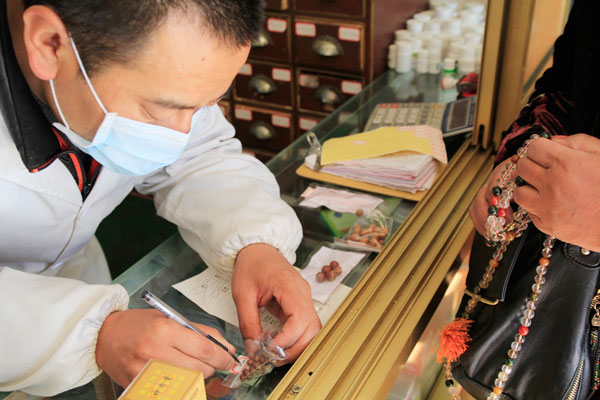Monk-doctors fill medical, spiritual needs
Updated: 2013-05-08 01:37
By Wang Huazhong and Palden Nyima in Lhasa (China Daily)
|
||||||||
 |
|
Pharmacist Tenzin writes the name of a traditionally made Tibetan drug on a tag for patients. Wang Huazhong / China Daily |
Past and present
Tseten Jigme said monasteries, both big and small, have spent money to train their in-house monk-doctors since ancient times.
The rise of monk-doctors began in the late eighth century, when Yuthok Yonten Gonpo founded the Tibetan medical science.
Since 1696, Desi Sangye Gyatso, regent of Tibet in the 17th century after the passing of the fifth Dalai Lama, established a medical college on the Chakpori Hill, and later another one beside the Potala Palace and a third one in Doilungdeqen county.
The colleges only admitted monks then.
In 1916, the predecessor of the Hospital of Tibetan Medical Science was established, with a tradition of selecting most students and practitioners from monasteries unchanged.
From 1916 to 1959, the colleges and hospitals trained more than 1,000 monk-doctors but only one female doctor, according to Tseten Jigme.
Then in 1959, the Chakpori Hill Medical College merged with another college to form today's Hospital of Tibetan Medical Science and began accepting students from society.
"Nowadays, we have few monk-doctors because there are professional hospitals and clinics everywhere in every county and village," said Tseten Jigme.
In 2011, the autonomous region's government began allowing monks and nuns to join the social medical insurance system on a voluntary basis. In 2012, hospitals began providing free body examinations to them.
"So, the need for monk-doctors has decreased substantially along with the development of the modern health system," Tseten Jigme said.
He added that the monk-doctors now can be found in the Sera, Drepung, Ganden, Tashilhunpo and Samding monasteries. Yet only the ones in Drepung and Tashilhunpo are open to the public.
Norbu, head of the medical administrative office of Lhasa city's health department, said authorities do not have an exact number of the group.

 Michelle lays roses at site along Berlin Wall
Michelle lays roses at site along Berlin Wall
 Historic space lecture in Tiangong-1 commences
Historic space lecture in Tiangong-1 commences
 'Sopranos' Star James Gandolfini dead at 51
'Sopranos' Star James Gandolfini dead at 51
 UN: Number of refugees hits 18-year high
UN: Number of refugees hits 18-year high
 Slide: Jet exercises from aircraft carrier
Slide: Jet exercises from aircraft carrier
 Talks establish fishery hotline
Talks establish fishery hotline
 Foreign buyers eye Chinese drones
Foreign buyers eye Chinese drones
 UN chief hails China's peacekeepers
UN chief hails China's peacekeepers
Most Viewed
Editor's Picks

|

|

|

|

|

|
Today's Top News
Shenzhou X astronaut gives lecture today
US told to reassess duties on Chinese paper
Chinese seek greater share of satellite market
Russia rejects Obama's nuke cut proposal
US immigration bill sees Senate breakthrough
Brazilian cities revoke fare hikes
Moody's warns on China's local govt debt
Air quality in major cities drops in May
US Weekly

|

|







